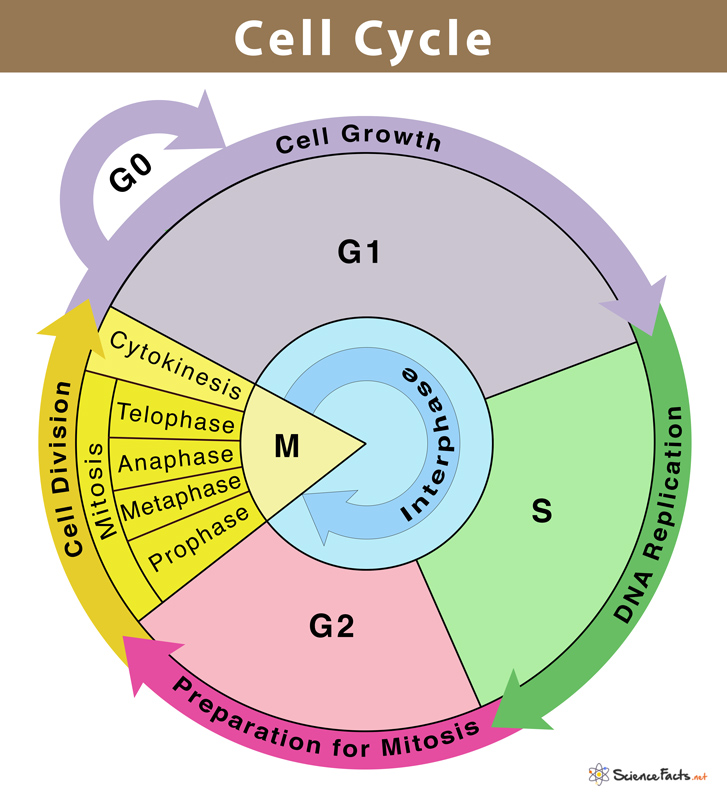Cell division is responsible for a newborn baby gradually growing into an adult. Similarly, a caterpillar turning into a butterfly. Other living organisms, such as a plant or bacteria, also follow a series of developmental stages following birth until reproduction.
Phases of the Cell Cycle
Regulation of Cell Cycle
Purpose and Importance of the Cell Cycle
The process of cell division is more straightforward in lower, single-celled (prokaryotes) organisms than higher multicellular (eukaryotes) ones. The reason is that a prokaryotic cell has a relatively simpler cell organization with a single circular chromosome, absence of a nucleus, and few cell organelles. In contrast, eukaryotic cells have multiple chromosomes present within a nucleus and various organelles. A eukaryotic cell cycle consists of two main parts: 1) interphase and 2) mitotic (M) phase, and an alternative part called the G0-phase.
1) Interphase
It is the first phase of the cell cycle, recognized by the growth period where the chromosome gets duplicated as the cell prepares for division. Interphase happens between one cell division or mitotic (M) phase and the next. It is the longest part of the cell cycle involving three sub-phases. The typical duration of this phase is 23 hours.
2) Mitotic (M) Phase
This period is also known as the cell division phase and occurs just after the G2-phase. Here, the cell divides its genetic material (DNA) and cytoplasm to form two new cells. The M-phase involves two different critical processes that unfold in the following order: a) Mitosis or Karyokinesis It is the nuclear division period and consists of four phases: prophase, metaphase, anaphase, and telophase. During this phase, the cell divides the nucleus and gets separated into two daughter cells, where each daughter cell receives a complete set of chromosomes. The details of its different phases are discussed in the mitosis article. b) Cytokinesis It is the process by which the cytoplasm of the cell splits to form two independent cells. The phase of cytokinesis begins towards the end of mitosis such that the two processes overlap. Cytokinesis is the shortest phase of the cell cycle that occurs differently in plants and animals.
The division in plant cells occurs by forming a cell plate structure in the middle of the cell. The cell plate is made of components made of the cell membrane and cell wall.The division in animal cells happens when a band of cytoskeletal fibers known as contractile rings forms just below the cell membrane in the metaphase plate’s position. The contractile rings contract inwards, thus creating a depression or crack, called cleavage furrow. The cracks increase, and slowly the membrane cleaves to form two daughter cells at the end of the cell cycle.
End Result Two individual daughter cells are formed, each having identical copies of the genetic material.
G0-phase
Some cells do not immediately enter another round of preparatory phase or interphase following the division or mitosis. Instead, they exit the G1 growth phase and enter a resting stage called G0-phase. Thus, G0 is also called the alternative phase of the cell cycle. Some cells enter the G0-phase temporarily until an outside signal triggers the onset of G1. In contrast, other cells that either never divide or seldom divide, such as nerve cells or cardiac cells, remain in G0-phase permanently. 1. G1-checkpoint: Present just before the entry into S-phase, it makes the critical decision whether the cell will enter the S-phase. The decision is based on whether the cell is big enough and has synthesized proteins necessary for DNA synthesis. 2. G2-checkpoint: Checks errors in the DNA-synthesis phase and, based on the result, bars the entry into the M-phase. This checkpoint helps to prevent the occurrence of cancer in higher animals. Suppose there is an error in DNA replication. In that case, the G2 checkpoint prevents the cell from progressing further in the cell cycle and checks the error in the newly formed DNA. 3. M-checkpoint: This occurs near the end of the metaphase stage. It checks whether all sister chromatids are correctly attached to the spindle fibers. The M-checkpoint ensures that equal division of chromosome occurs between the two daughter cells. In case the above cell cycle regulators do not function properly, the organism may end up with too few or too many cells. Apart from the above checkpoints, many growth factors and chemicals stimulate the cell to progress through the cell cycle.
Why is Cancer Considered a Cell Cycle Disease?
Cancer is a disease caused by uncontrolled cell division. As discussed above, any error in DNA-synthesis leads to an alteration in the behavior of the cell. Multiple checkpoints keep track of the cell cycle’s entire process to prevent mistakes in growth and DNA synthesis. One such control, G2-checkpoint, inhibits the cell with a damaged DNA to proceed further in the cell cycle, a process called cell-cycle arrest. In this way, the cell avoids the formation of cancer. Thus, cancer and cell cycle are related to each other.
